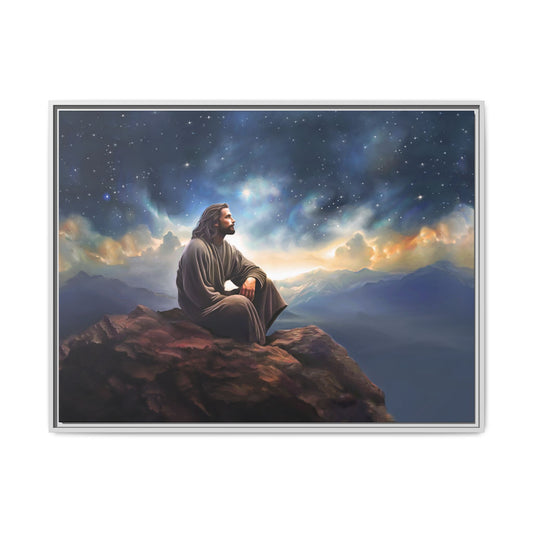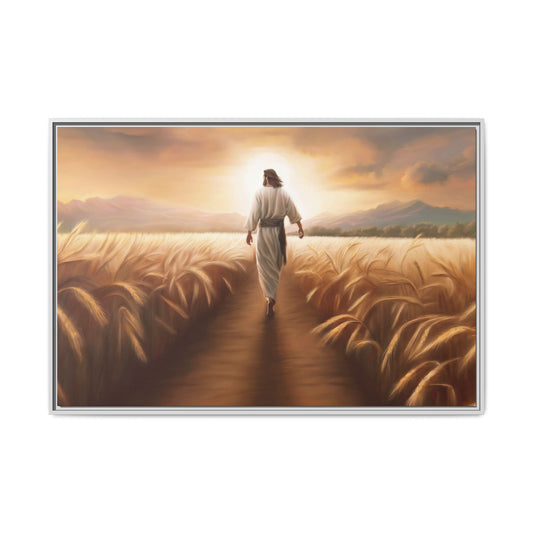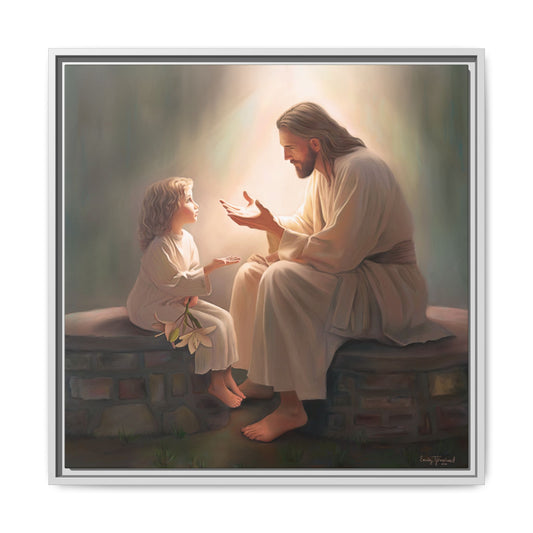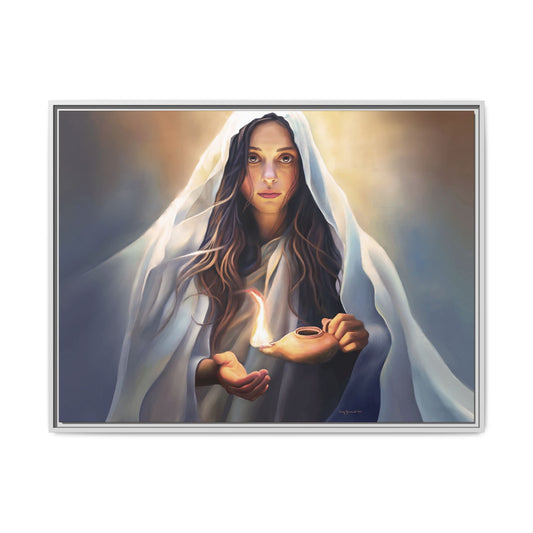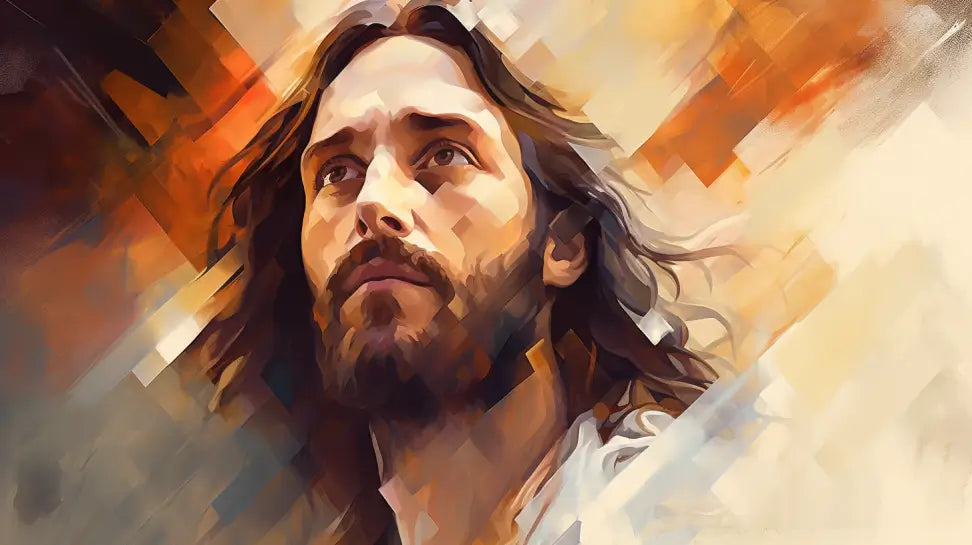
Jesus Christ Face
Share
We've all heard of the Holy Face of Jesus, but what does it really mean to us?
For centuries, this powerful symbol has captivated and inspired people around the world.
From its visual representation to its spiritual significance, the Holy Face of Jesus has become a source of devotion and reverence.
Join us as we explore the history, evolution, and controversies of this iconic image and discover its power to bring us closer to God.










Keeping in mind the evolution of Jesus' depiction, these iconic portraits capture significant characteristics and symbolism that illustrate his humanity.
His eyes, often portrayed as a deep brown, show a loving, compassionate gaze. His dark hair and olive skin speak to his Middle Eastern origin. The light that often radiates from him conveys his divine nature.
It's also a reminder of his birth, when a star shone so bright that the Magi followed it, eventually leading them to the Christ child.
These portraits serve as a reminder of Jesus' humanity and his divine mission. They also remind us of our own mission to love and serve others as he did during his earthly life.












Key Takeaways
- Devotion to the Holy Face of Jesus is a Catholic tradition that involves contemplating the wounds on the Face of Jesus and offering reparation for the insults he suffered in his Passion.
- The Holy Face devotion is based on the image on the Shroud of Turin and is practiced through the Holy Face Medal, which consoles Jesus.
- The Holy Face devotion was approved by Pope Leo XIII in 1895 and Pope Pius XII in 1958, and Pope Pius XII declared the Feast of the Holy Face of Jesus as Shrove Tuesday for all Roman Catholics.
- The theological analysis of Holy Face devotions includes discipleship, seeing Jesus in the Eucharist, and the eschatological element, which involves awakening to Christ through the Eucharist.

What Do We Know About Jesus Christ's Face
From the earliest artistic representations of Jesus to modern scientific attempts to recreate his face, the topic of Jesus Christ's face has long been a source of fascination. In this article, we'll explore the history of Jesus portraits, devotions, and theological analysis that can help us better understand and appreciate Jesus' face. We'll also explore the controversies, search for Jesus' DNA, and scientific attempts to reconstruct Jesus' appearance.
Briefly Introduce the Topic of Jesus Portraits and Their Significance
We don't know much about Jesus Christ's face, but we do know that his portrait has become a source of spiritual significance for many. Over the centuries, artists have depicted Jesus in various ways, reflecting the cultural and artistic influences of different regions and times. These portraits have been used to evoke different emotions and encourage deeper contemplation of Jesus' life and teachings. From the earliest images of Jesus to modern interpretations, each portrait has the potential to inspire reverence and worship as we strive to more deeply know and honor Jesus Christ. Portraits of Jesus also serve as reminders of his love and sacrifice, providing us with an opportunity to express our gratitude and devotion. The aim of this article is to provide helpful information about Jesus portraits and promote worshipful expressions of art.
Explain the Aim of the Article - To Provide Helpful Information About Jesus Portraits and Promote Worshipful Expressions of Art
We're here to provide helpful information about Jesus portraits and promote worshipful expressions of art, to help us better understand what we know about Jesus Christ's face. From the Holy Face of Jesus to the Veronica, the devotion to Christ's face has been celebrated through history by those like Sr. Marie of St Peter and Leo Dupont. Thérèse of Lisieux and Maria Pierina De Micheli helped spread the devotion further, and it was approved by Popes Leo XIII and Pius XII. Pope John Paul II even emphasized the need to reflect on Christ's face, leading to the formation of the International Institute for Research on the Face of Christ. Biblical accounts and scientific attempts to reconstruct Jesus' appearance show how powerful visual representation can be in understanding our Lord and God.
The Power of Visual Representation
Throughout human culture and history, visual representations have played an essential role in how we understand and relate to the world around us. As Christians, Jesus portraits have been especially powerful in enabling us to connect with the divine and express our spirituality. In this article, we'll explore the impact of visual representation in the context of Jesus Christ's face.
Discuss the Impact of Visual Representation in Human Culture and History
A look at the history of Jesus Christ's face shows how powerful visual representation can be in influencing human culture. From the Holy Face of Jesus to the Veronica, to Leo Dupont's Eucharistic Adoration movement, to Sr. Marie of St Peter's interior locution and Thérèse of Lisieux's introduction of a devotion to the Holy Face, to the vision of Maria Pierina De Micheli, the devotion to the Holy Face has been a part of the Christian faith for centuries. Approved by Pope Leo XIII in 1895 and Pope Pius XII in 1958, it was given to soldiers and sailors during World War II for protection. Pope John Paul II emphasized the need for deeper reflection on the Face of Jesus and the spread of devotion to it. His fatherly words remind us of the religious and historical importance of the Holy Face, which gives us a deeper appreciation for the power of visual representation.
Explain How Jesus Portraits Have Played a Role in Christian Worship and Spirituality
For centuries, Christians have used images of Jesus to deepen their spiritual connection to the divine and to aid in their worship. Visual representations of Jesus have been a powerful tool for Christian faith, allowing believers to connect to holy gospel stories and to experience Jesus in a personal way. Through artistic depictions, devotionals, prayers, and commemorative medals, it's possible to meditate on Jesus' face and contemplate his passion. We can look upon the holy face of Jesus and be inspired to imitate his love and sacrifice. To honor him, we can offer acts of reparation for the insults he suffered during his passion. Through faith, we can be brought closer to Jesus and experience his unending grace and mercy.
The Importance of the Jesus Christ Face
The face of Jesus Christ is an important part of Christian iconography. It has symbolized many aspects of faith and devotion for centuries. We'll explore the significance and theological importance of the face of Jesus Christ. Additionally, we'll discuss its symbolism in Christian art and devotional practices.
Explore the Significance of the Face of Jesus Christ in Christian Iconography
How have depictions of Jesus' face throughout history and today impacted Christian iconography? From the Holy Face of Jesus to the Veronica, various devotions and practices have been approved by the Vatican and celebrated on the Feast of the Holy Face of Jesus. Theological analysis has revealed three components of the devotion: discipleship, seeing Jesus in the Eucharist, and the eschatological element. Institutes such as the International Institute for Research on the Face of Christ continue to explore and spread the devotion. Biblical accounts and scientific attempts to reconstruct Jesus' appearance provide further insight into the significance of Jesus' face. This exploration of Jesus' face reveals its importance to Christian iconography. By reflecting on the Face of Christ, we can gain a deeper understanding of his teachings and mission, ultimately leading us closer to him.
Discuss the Theological and Symbolic Aspects Associated with Jesus' Face
Building on the previous exploration of the Face of Christ, let's discuss the theological and symbolic aspects associated with Jesus' face and its importance in Christian iconography. The devotion to Jesus' face has been practiced in the Catholic tradition since the 19th century and is largely focused on reflecting on the wounds and insults that Jesus suffered during his Passion. Jesus' face is seen as a divine symbol that reveals his divine power and mercy. The Holy Face Medal, approved by Pope Pius XII, was given to soldiers and sailors during World War II for protection and is still used today in devotions to Jesus. Through the devotion to the Holy Face, the faithful are called to discipleship and to see Jesus in the Eucharistic experience. Pope John Paul II emphasized the need for deeper reflection on the Face of Christ, urging us to make his face shine before future generations. We must remember, however, that the Bible offers few clues about Christ's physical appearance. This leads us to the next section: the history of Jesus portraits.
The History of Jesus Portraits
Since the earliest days of Christianity, the face of Jesus has been captured in countless portraits throughout the centuries, each artist leaving their unique imprint on this beloved figure. From the Byzantine era to the Renaissance, Baroque, and Neo-Classical periods, many renowned artists have created their own interpretations of Jesus Christ. Let's explore the many faces of Jesus and gain insight into the history of art from different eras.
Trace the History of Jesus Portraits from Early Christianity to the Present Day
We've traced the history of Jesus portraits from early Christianity to the present day. From ancient images to modern depictions, Jesus' face has captivated viewers throughout time. Here's a look at the evolution of Jesus portraits:- Ancient: Third century A.D. images often depicted Jesus as a young, short-haired, beardless man.
- Greek and Roman influence: Fourth century and onwards featured Jesus with long hair and a beard.
- Different cultures: Worldwide artwork based on the artist's own racial identity.
- Western art: Standardized 'Jesus we recognize' used in modern depictions.
- Scientific attempts: Forensic anthropologists and computer programmers created a new image in 2001.

Key Artistic Movements and Notable Artists Who Created Jesus Portraits
Continuing our exploration of the history of Jesus portraits, let's take a closer look at key artistic movements and notable artists who created them. From the mid-third century A.D., Jesus was often depicted as a young, short-haired, beardless man. The long-haired, bearded image emerged in the fourth century, influenced by Greek and Roman gods. Around the world, cultures have depicted Jesus according to their own racial identity. Power, truth, and love come alive through these images, conveying the beauty and divinity of Jesus. Notable artists like Leonardo da Vinci, Michelangelo, and Raphael created iconic works of Jesus. Their art has inspired generations of people to seek the truth and love of Jesus. Through these artistic movements, we can glimpse the grandeur of Jesus and experience the power of his love.
 The Characteristics and Symbolism Captured in These Portraits
The Characteristics and Symbolism Captured in These Portraits
Keeping in mind the evolution of Jesus' depiction, these iconic portraits capture significant characteristics and symbolism that illustrate his humanity.
His eyes, often portrayed as a deep brown, show a loving, compassionate gaze. His dark hair and olive skin speak to his Middle Eastern origin. The light that often radiates from him conveys his divine nature.
It's also a reminder of his birth, when a star shone so bright that the Magi followed it, eventually leading them to the Christ child.
These portraits serve as a reminder of Jesus' humanity and his divine mission. They also remind us of our own mission to love and serve others as he did during his earthly life.
Different Interpretations of Jesus' Face
Throughout history, Jesus' face has been interpreted and depicted in a variety of ways, reflecting the cultural, historical, and artistic influences of the time. From the earliest artistic representations to images of Jesus from different cultures around the world, we explore the diverse interpretations of Jesus' face.
Explore the Diverse Ways in Which Artists Have Interpreted and Depicted Jesus' Face
Frequently, we see Jesus portrayed in various ways, each interpretation unique in its own right. Artistic depictions have been present for centuries, ranging from images of Jesus on the Shroud of Turin to the modern day forensic reconstruction of his face. Here are a few examples of how Jesus has been interpreted:- Byzantine-era icons, such as the Pantocrator, depict Jesus as an elderly, bearded man in a long robe.
- Renaissance painters, such as Michelangelo, often portray Jesus as a younger man with light skin.
- John and Paul, two apostles of Jesus, are credited for introducing a more racially diverse Jesus.
- Modern day artists, such as Kehinde Wiley, depict Jesus as a man of color.
- Films, such as Jesus of Nazareth, depict Jesus as a man who looks like an average person.

Discuss the Cultural, Historical, and Artistic Influences on These Interpretations
We are able to see the clear influence of culture, history, and art on interpretations of Jesus' face. In the early centuries of Christianity, Jesus was typically depicted as a young, short-haired man with no beard. Later on, influenced by Greek and Roman gods, artists portrayed Jesus with a long beard and hair. In more recent times, Jesus has been depicted according to the racial identity of the culture creating the art. These interpretations all serve to remind us of the sacredness of Jesus' life and death, and the special living legacy he left behind. Images of Jesus have evolved to represent a man of good character and high moral standing. Through the depictions of Jesus' face, we're reminded of his love and compassion and our own need to strive to be better people.
The Power of Jesus Portraits in Worship
We can explore the power of Jesus portraits in worship by considering how these visual aids can evoke feelings of reverence, awe, and connection with the divine. Through their presence, these portraits can help us focus our minds and hearts more deeply on the divine and make our worship more meaningful.
Discuss How Jesus Portraits Can Serve as a Visual Aid in Worship and Personal Devotion
We can use reproductions of Jesus portraits in worship and personal devotion to help us focus more deeply on our relationship with Jesus. Visual aids can provide a tangible connection to Jesus that can inspire and motivate us to seek a deeper spiritual bond with Him. Such tools can provide an excellent resource for personal, communal and congregational worship. Here are five ways Jesus portraits can serve as a visual aid in devotion:- Help to focus on the presence of Jesus in our lives
- Increase awareness of Jesus' physical appearance
- Spur contemplation on the life and teachings of Jesus
- Inspire reverence and respect for Jesus
- Deepen our spirit of devotion to Jesus.

Explore Their Ability to Evoke Feelings of Reverence, Awe, and Connection with the Divine
Experiencing reverence, awe, and connection with the divine through Jesus portraits can be a powerful part of our spiritual journey. Jesus' image is often seen as a king, but the story of his life speaks to us on a personal level. His presence in our lives can evoke feelings of deep respect and admiration, as well as a strong sense of connection with the divine. By looking upon his portrait, we can be reminded of the sacrifice he made and the way in which he chose to serve others. This reminder can help us to live our lives with intention and purpose, and to strive for a closer relationship with God. Through Jesus portraits, we can find the strength and courage to become the best version of ourselves and lead lives that make a difference in the world.
Debates and Controversies Surrounding Jesus Portraits
We are all familiar with the iconic image of Jesus Christ. However, there's much debate and controversy surrounding the accurate depiction of Jesus' face. Ethical concerns are raised when creating and promoting Jesus portraits. It's important to consider these questions thoughtfully.
Address Controversies Surrounding the Accurate Depiction of Jesus' Face
Controversies and debates surrounding accurate depictions of Jesus' face have been around for centuries. From the Shroud of Turin to the Holy Face Medal, people have sought to understand the image of Christ, and to reconcile their faith with the facts. Keywords such as people, image, and fact have guided the search to discover the truth. There have been attempts to reconstruct Jesus' face using the latest technological advances, as well as scientific attempts to locate his DNA. Artistic representations of Jesus have also evolved over time, with different cultures depicting him according to their own racial identity. Despite all the efforts to uncover the face of Christ, no one can truly know the exact image of the Son of God. This section has addressed the controversies surrounding the accurate depiction of Jesus' face, and now, it's time to discuss ethical concerns related to creating and promoting Jesus portraits.
Discuss Ethical Concerns Related to Creating and Promoting Jesus Portraits
Following the controversies surrounding the accurate depiction of Jesus' face, we now turn to ethical concerns related to creating and promoting Jesus portraits. Creating images of Jesus and using them to promote religious devotion can be a great way to live out our faith. But it's important to remember that Jesus is a real person and not just an abstract concept. We must be careful to create true and meaningful representations of him that don't diminish the great mystery of who he is. There's a delicate balance between creating art that honors Jesus and using it to manipulate worshipful responses. We must strive to create representations of Jesus that bring us closer to him while avoiding those that are spiritually shallow or manipulative. This encourages worshipful expressions of art that help us to draw closer to Jesus in a meaningful way.
Encouraging Worshipful Expressions of Art
We can honor the Holy Face of Jesus in our art by creating expressions of worship that are respectful and sensitive. As we strive to capture the beauty, grace, and love of Jesus in our art, we should be mindful of the theological implications of our work. We should do our best to create art that will encourage others to draw closer to Him.
Provide Practical Tips for Individuals and Communities to Engage in Worshipful Art
As a community of worshippers, let's explore practical tips to foster worshipful art expressions:- Create a comfortable space for creative expression, where people can work with their hands and hearts.
- Invite participants to explore their lives and the lives of others with an eye toward discovering the human element in their work.
- Encourage collaboration and connection by providing supplies and materials that can be shared and used together.
- Celebrate the individual's effort and encourage the growth of the group's collective work.
- Invite everyone to contribute ideas, insights, and resources that can enrich the worshipful art experience.

Highlight the Importance of Respectful and Sensitive Approaches in Creating Jesus Portraits
While creating expressions of art with Jesus as the focus, it's important that we respect and sensitively approach these works. We must keep in mind that our subject is a man who represents service to others. We should strive to capture an image that's reflective of His message of love and compassion. Our language must be inspiring, reverent, and appropriate for those who desire to serve. We must also be mindful of the many interpretations of Jesus throughout history, and ensure our work reflects our own individual perspectives. It's our responsibility to portray Him in the most respectful and sensitive manner possible, as we seek to honor and glorify Him through our worshipful expressions of art.
Conclusion
We've explored the history, devotions, and theological analysis of the Holy Face of Jesus, and the Vatican's approval and feast day of the devotion. We've also looked at institutes, related concepts, biblical accounts, and the evolution of depictions of Jesus over time. Through this examination, we've seen the value of Jesus portraits in deepening one's faith and fostering worshipful experiences.Summarize the Key Points Discussed in the Article
Summarizing the key points discussed in this article, we've learned about:- The origins and historical figures related to the devotion to the Holy Face of Jesus
- Devotions and practices associated with the Holy Face of Jesus
- Vatican approval and feast day dedicated to the Holy Face of Jesus
- Theological analysis of the significance of the Holy Face of Jesus
- Institutes and related concepts centered around the devotion to the Holy Face of Jesus
- Biblical accounts and the lack of detailed description of Jesus' appearance
- The evolution of depictions of Jesus' physical appearance over time

Reinforce the Value of Jesus Portraits in Deepening One's Faith and Fostering Worshipful Experiences
Recognizing the importance of Jesus portraits to our faith and worship, we embrace the beauty of these depictions. Through these depictions, we can gain a new understanding and experience of Jesus, deepening our faith and bringing us ever closer to him. With the help of art, we can have a vivid visualization of Christ, helping us to reach a deeper point of reverence and contemplation. The Holy Face of Jesus is a powerful symbol that can draw us closer to our faith, allowing us to truly experience the love of the divine.

